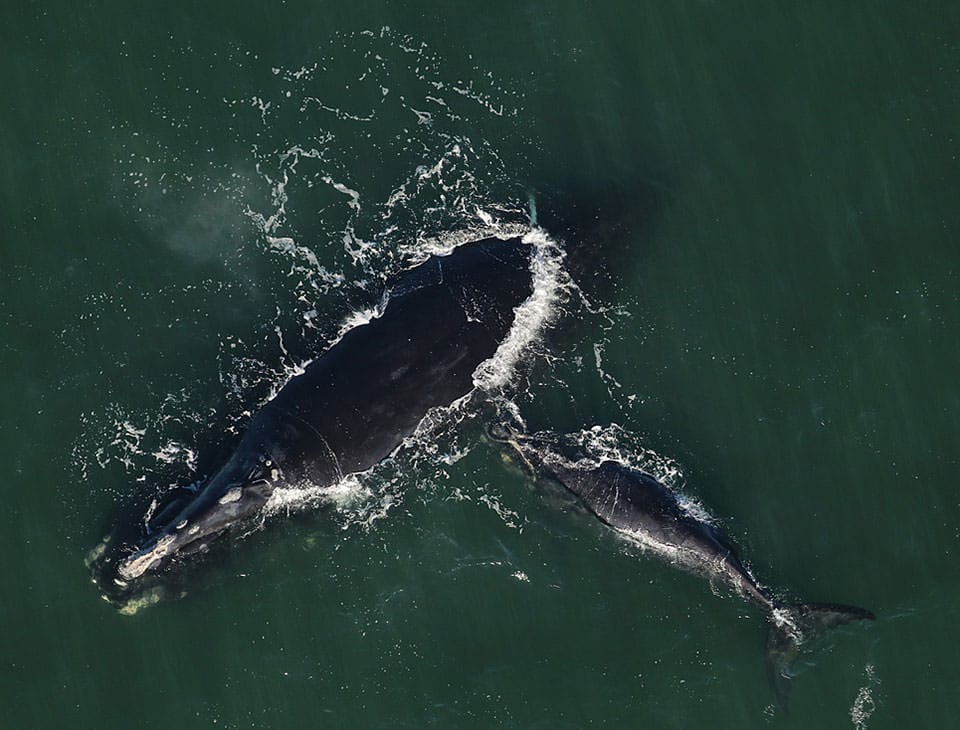North Atlantic right whales are the rarest marine mammals worldwide. A new study by the Diseases of Aquatic Organisms finds that the right whales are currently less than 366 of them left in the wild. Today, many scientists, government agencies, and ship crews are devoting their time to promote the welfare of these majestic whales!
Vessel strikes, entanglements, and underwater noise pollution severely harm the overall health of the North Atlantic right whale population, continuously bringing their numbers down, bringing them at the brink of extinction.
The North Atlantic Right Whale
These whales weigh up to 140,000 pounds, with their lengths stretching to more than 50 feet. They’re magnificently sized creatures that feed on tiny crustaceans and zooplankton by filtering massive amounts of ocean water through their baleen plates. Right whales often fly above the water and crash back down with a loud splash!
Groups of North Atlantic Right whales often interact with one another at the water’s surface, where they mate and socialize with each other. Their social interactions are inclusive to all seasons throughout the year and in all their habitats. Low-frequency moaning and groaning is their form of communication wherein these sounds can hint at threats and potential aggression.
North Atlantic right whales preside in the vast waters of the Atlantic, seasonally migrating alone or in groups in the deep oceans. One can also see North Atlantic whales in the New England and Canadian regions, where the whales are known to mate. Some North Atlantic whales travel for more than a thousand miles every fall, and migration patterns are not absolute.
The National Oceanic and Atmospheric Administration have determined crucial habitats for the North Atlantic whales, labeled as essential habitats that provide the whales the necessary conditions for feeding, nursery, and calving. These are: off the coast of New England and on the southeast U.S. coast from Cape Fear, North Carolina, to Cape Canaveral in Florida. (Source: Fisheries)
Lessening in Reproduction
North Atlantic Right Whales live up to 70 years. Their ear wax is used to tell their age. The right whales’ lifespans are now only 45-65 years old, reduced primarily due to human-related mortality cases. Adult female deaths are more prominent than the deaths of adult males, and this is mainly due to adult female right whales being more prone to dying from severe injuries caused by entanglement and vessel collisions.
Female right whales can give birth once a year when they’ve reached the sexually capable age of 10. But currently, they are only reported to give birth every 6 to 10 years. Biologists believe that the lessening of calving is because of the various stressors they experience. (Source: Fisheries)
Extinction of the North Atlantic Right Whales
North Atlantic right whales are the most endangered large whale species. Currently, there are less than 366 North Atlantic right whales. Many threats contribute to the harmed welfare and the decreasing population of the North Atlantic right whales. Climate change, vessel strikes, entanglements, and underwater noise pollution caused by human activities have highly impacted the health and reproduction of the species.
Since 2017, right whales have experienced an unusual mortality event (UME) affecting 50 North Atlantic right whales. Their stranded bodies were mainly seen in Canada and the United States. In the year 2021, two documented deaths have already been reported. The number of right whale deaths already accounts for more than 10% of their population, with the majority of the deaths caused by vessel strikes.
Michael Moore, a whale trauma specialist, emphasizes the significance of trauma reduction measures and the application of new tools in assessing the whales’ health in tackling the risk of extinction the North Atlantic right whales currently face.
Human-caused threats and varying ocean conditions majorly affect the whales’ migration patterns and behavior. Prioritization of the recovery of the North Atlantic right whales is essential. Scientists are giving their utmost efforts to provide appropriate data regarding vessel traffic and commercial traffic. Pinpointing these threats with the collaboration of ship crews and government agencies will ensure the production of proactive solutions. (Source: UME)
